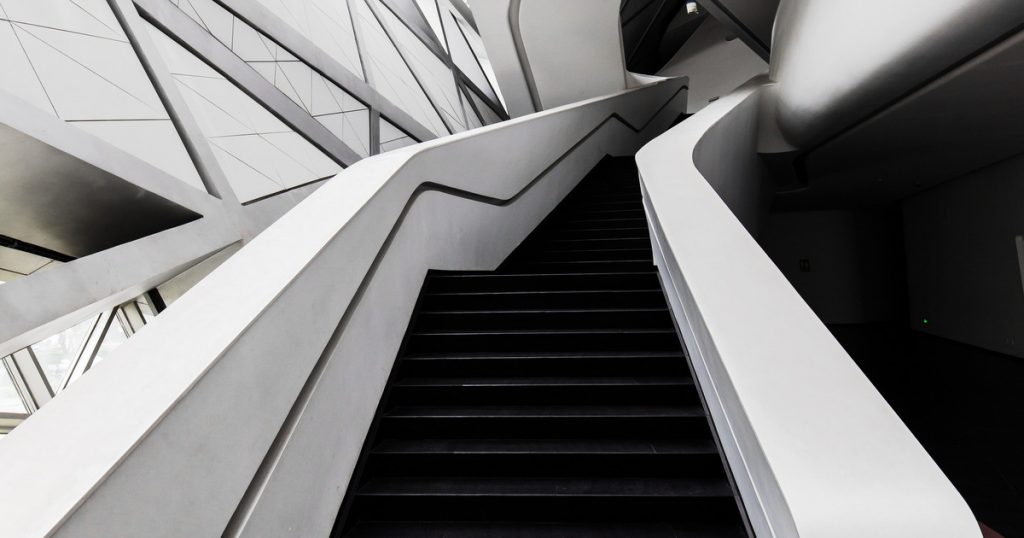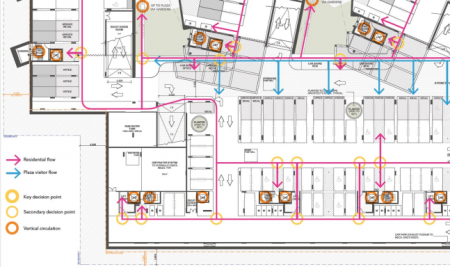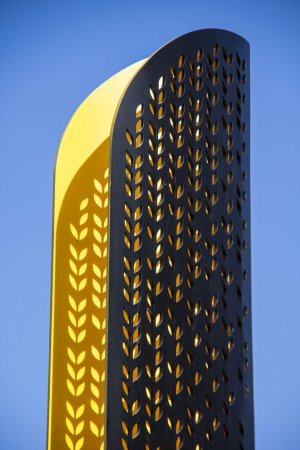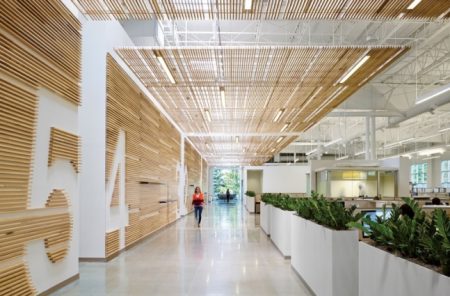
What is wayfinding
Wayfinding is an information system that assists customers and visitors to navigate around and through a space. Although the civil design and architecture foundations of a site dictate how people move around at a structural level, the wayfinding system is the communication layer guiding the navigation into and throughout the built environment.
Wayfinding systems vary in complexity according to the characteristics of the site or precinct and it can include many different solutions to achieve a smooth customer journey. They can combine maps, symbols, signage, art installations, typefaces and any other form of communication which can be designed to guide visitors and customers according to the specific site requirements.
Wayfinding design process
Observing the customer’s behaviour
Wayfinding is a people-centric science; therefore, its design process starts with observing users’ behaviour. The customer and visitors relationship with the site and how they move around is the most important input when designing a wayfinding system for an existing site.
In addition to that, the designer will analyse which aspects of the environment can be enhanced or used to facilitate the orientation process without the need for signage. This includes evaluating the architecture, landscape and natural resources looking for opportunities to create intuitive wayfinding.
Journey mapping
The next stage is to determine the journey paths by defining the right route for different user groups to move from their point of arrival to their desired destination. The user groups should be segregated not only by their interests and behaviours but also by their mode of travel.
In the journey paths, individuals will encounter a series of decision points and it is the role of the wayfinding system to provide the information that the customer needs at exactly the right moment to make a decision and arrive at the next decision point successfully.
Concept design, design development and final stages
A wayfinding designer will then create the concept designs, incorporating the client’s brand. Colours, shapes, materials and other inspirational features of a project or site will be drawn upon to produce the concepts.
The process continues with the design development of the concepts and preparation of the location plans and messaging schedules. The following stage is documentation and preparation of finished artwork ready for manufacturing purposes.
The process described above is a brief overview of the wayfinding design process. When thinking of wayfinding, people often perceive it as a synonym for a signage system. Our objective is to demonstrate that the signage design is one part of the wayfinding outcome. Effective wayfinding is highly dependent on the accuracy of the entire process.
How to identify a good wayfinding system
The most obvious way to assess the quality of a wayfinding system is to observe its efficiency in guiding customers and visitors without frustration. A successful wayfinding system will support a seamless, stress-free experience. However, this evaluation can only be done after the wayfinding system has been put in place.
Nevertheless, there are a number of components to be considered in designing a quality wayfinding system which will ensure a positive outcome; we discuss some of these below:
1. Zoning and spaces
The wayfinding system needs to identify the different zones of the built environment. In a hospital, these would include for example, the emergency room, operating theatres, private rooms, reception, etc. In a shopping centre, the food and retail areas could be differentiated.
Additionally, each user group will have different routes and needs which should be addressed accordingly. For instance, drivers and pedestrians may have different arriving points and those should be easily found in both cases. In the same way, parents with prams and adults without children will have different accessibility requirements that also should be considered when designing the wayfinding system. The needs of people arriving on bicycles also need to be considered.
Therefore, the key questions you should be asking at this point are:
- What are the different user groups of this precinct/building/town centre? Were they all considered in the design?
- What are the main zones of this precinct/building/town centre? Are they clearly identified?
2. Journey paths

The paths should intuitively minimise the customer decision-making process. Journey mapping is a crucial element to ensure that all the decision points have been considered and that eventual disruptions along the journey mitigated.
Obviously, this is connected to the previous point and it should be developed according to the different user groups. Hence, you should put yourself in the customer or visitor’s shoes and see the space through their eyes.
The main aspects to consider are:
- How easy is it to navigate in the space? Do the paths lead to the different zones of the precinct/building without major disruption?
- Engage with key stakeholders at this stage to gather relevant feedback. VR can assist in collecting this type of information. By using this technology clients can experience the look and feel of a proposed wayfinding system within the project space.
3. Branding & graphics considerations

An essential aspect of wayfinding is to ensure an alignment with the brand. The application of the brand to the wayfinding system includes the choice of colours, shapes, materials and finishes.
Therefore, the evaluation of this aspect relates to considering if the wayfinding system contributes to the success of the brand strategy.
- Are the materials, colours, shapes, patterns, etc. aligned to the brand guidelines?
- Does the wayfinding positively contribute to the architecture and interior design?
4. Signage design

With signage design, there are some elements that can be included in the evaluation.
Functionality – encompasses the signage visibility, legibility, compliance and safety. Simply put, it is necessary to ensure that all users can access the information when they need it (different times of the day and at variable distances) and that it is designed in accordance with current standards.
Spatial considerations – this aspect relates to the usage of the available space and the distribution of the pieces of information to create the desired impact or to ensure that the user has all that he or she needs to navigate the space. Typically, wayfinding signage is located on the walls or suspended from the ceiling but in some cases, it may be located on the floor or projected onto walls.
Material considerations – materials need to be selected according to their compatibility with the brand look and feel and also the required longevity. Materials can be used to integrate the wayfinding communication with the built environment. Additionally, it is essential to ensure that the materials are durable and for external wayfinding, can resist environmental factors such as rust, sunlight, strong winds, etc.
A good wayfinding system is a crucial aspect of the customer journey. It will avoid making your customers and visitors frustrated and ensure their ultimate satisfaction.
Related content:
A wayfinding system developed for children
Exploring internal and external wayfinding communication
Moscow Metro new wayfinding signage in time for the 2018 World Cup
Download the PDF version of this article:
